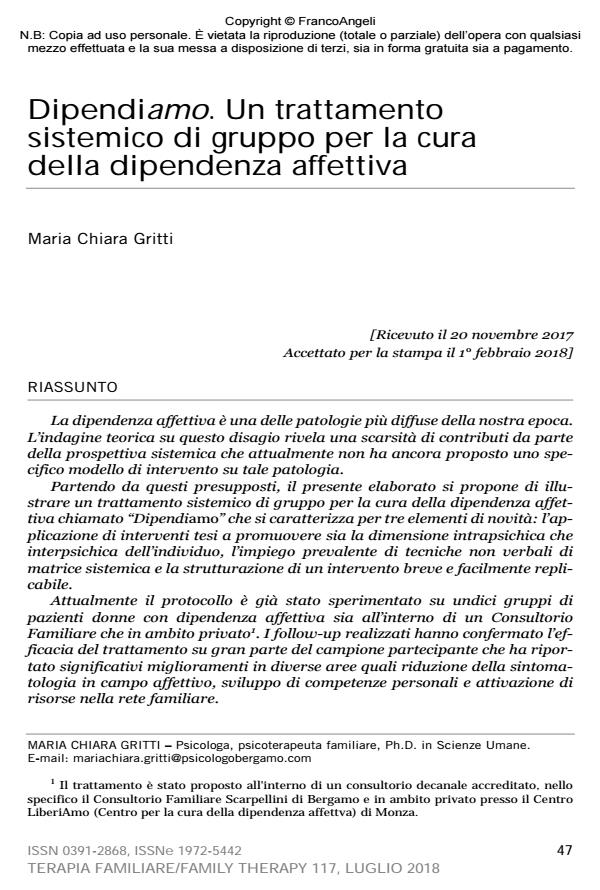We dewpend. A group systemic treatment to heal emotional addiction
Journal title TERAPIA FAMILIARE
Author/s Maria Chiara Gritti
Publishing Year 2018 Issue 2018/117
Language Italian Pages 23 P. 47-72 File size 203 KB
DOI 10.3280/TF2018-117004
DOI is like a bar code for intellectual property: to have more infomation
click here
Below, you can see the article first page
If you want to buy this article in PDF format, you can do it, following the instructions to buy download credits

FrancoAngeli is member of Publishers International Linking Association, Inc (PILA), a not-for-profit association which run the CrossRef service enabling links to and from online scholarly content.
Affection addiction is one of the most wide spread pathologies of our time. An investigation in the theory reveal a deficiency of literature in affection addiction from a systemic prospective. A specific intervention method for this pathology has not yet been proposed. This relation describes the systemic group for affection addiction treatment called "Dipendiamo" which, starting from an "individual-familiar" prospecti- ve of the problem (Selvini, 2008), brings forth three new elements: the appli- cation of interventions aimed to promote both intra-psychic and inter-psychic dimensions of the subject, the use of non verbal techniques of systemic matrix and the organization of a rapid intervention and easily replicable. This method has been used experimentally on eleven groups of women with affection addic- tion both within a Familiar Clinic and a private clinic2. Follow-up studies con- firm the effectiveness of the treatment for the vast majority of the subjects who participate. The data shows a substantial improvement in issues such as the reduction of symptomatology involving affection, personal skill development and activation of resources within the familiar network.
Keywords: Affection addiction; systemic group treatment; integration between individual and family resources; systemic techniques; group setting.
- Attaccamento e incastri di coppia tossici, in stallo e terapeutici Matteo Selvini, Maria Chiara Gritti, in TERAPIA FAMILIARE 132/2023 pp.27
DOI: 10.3280/TF2023-132002 - Understanding Psychological and Psychopathological Facets in Love Addiction: Preliminary Results Roberta Gabriella Cavalli, Camilla Tacchino, Patrizia Velotti, in Sexual Health & Compulsivity /2025 pp.1
DOI: 10.1080/26929953.2024.2392202 - Love Addiction, Emotional Dysregulation and Attachment Bonds: A Quantitative Study of 344 Females Alice Salani, Paolo Antonelli, Gioele Salvatori, Maria Chiara Gritti, Rossano Bisciglia, Francesca Mascherini, Davide Dèttore, in Sexual Health & Compulsivity /2022 pp.127
DOI: 10.1080/26929953.2022.2110546
Maria Chiara Gritti, Dipendiamo. Un trattamento sistemico di gruppo per la cura della dipendenza affettiva in "TERAPIA FAMILIARE" 117/2018, pp 47-72, DOI: 10.3280/TF2018-117004